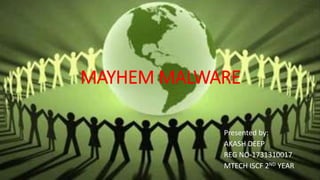Denunciar
Compartir

Recomendados
Recomendados
Más contenido relacionado
La actualidad más candente
La actualidad más candente (19)
2009-08-11 IBM Teach the Teachers (IBM T3), Linux Security Overview

2009-08-11 IBM Teach the Teachers (IBM T3), Linux Security Overview
Threats, Vulnerabilities & Security measures in Linux

Threats, Vulnerabilities & Security measures in Linux
Abusing, Exploiting and Pwning with Firefox Add-ons

Abusing, Exploiting and Pwning with Firefox Add-ons
Security Onion: peeling back the layers of your network in minutes

Security Onion: peeling back the layers of your network in minutes
Destacado
Destacado (8)
Kolb mpleting the kolb learning styles questionnaire

Kolb mpleting the kolb learning styles questionnaire
Similar a Mayhem malware
Similar a Mayhem malware (20)
formation malware CSC50 pour les attaque malware .ppt

formation malware CSC50 pour les attaque malware .ppt
Practical Malware Analysis: Ch 11: Malware Behavior

Practical Malware Analysis: Ch 11: Malware Behavior
Mayhem malware
- 1. MAYHEM MALWARE Presented by: AKASH DEEP REG NO-1731310017 MTECH ISCF 2ND YEAR
- 2. INTRODUCTION • Malware, short for malicious software, is any software used to disrupt computer operation, gather sensitive information, or gain access to private computer systems. • Mayhem’ – new piece of malware that is being used to target Linux and FreeBSD web servers in order to make them a part of the wide botnet, even without the need of any root privileges. • A botnet is a collection of Internet-connected programs communicating with other similar programs in order to perform tasks. • Targets to infect only those machines which are not updated with security patches. • The infection of websites and even entire web servers has become common. • Mayhem is a multi-purpose modular bot for web servers.
- 3. WORKING • After execution, the script kills all ‘/usr/bin/host’ processes, identifies the system architecture (x64 or x86) and system type (Linux or FreeBSD), and drops a malicious shared object named ‘libworker.so’. The script also defines a variable ‘AU’, which contains the full URL of the script being executed. • The PHP dropper creates a shell script named ‘1.sh’. Besides all of this, the script also creates the environment variable ‘AU’, which is the same as the one defined in the PHP script. • PHP dropper executes the shell script by running the command ‘at now -f 1.sh’. • The dropper waits for at most five seconds, then deletes the corresponding cron task.
- 6. HIDDEN FILE SYSTEM • The malware uses a hidden file system to store its files. • The filename of the hidden file system is defined in the configuration, but its name is usually ‘.sd0’ • The hidden file system is used to store plug-ins and files with strings to process: lists of URLs, usernames, passwords. • None of which were detected by the VirusTotal malware scanning tool.
- 7. SPREAD BY PLUGINS • Communication of the system is established with the command and control servers, which can send the malware different instructions. • Its functions can be expanded through plugins and at the moment some eight plugins have been discovered- • rfiscan.so - Find websites that contain a remote file inclusion (RFI) vulnerability • wpenum.so - Enumerate users of WordPress sites • cmsurls.so - Identify user login pages in sites based on the WordPress CMS • bruteforce.so - Brute force passwords for sites based on the WordPress and Joomla CMSs • bruteforceng.so - Brute force passwords for almost any login page • ftpbrute.so - Brute force FTP accounts • crawlerng.so - Crawl web pages (by URL) and extract useful information • crawlerip.so - Crawl web pages (by IP) and extract useful information
- 8. AFFECTED SYSTEMS... • 1,400 Linux and FreeBSD servers around the world that have compromised by the malware. • Most of the compromised machines are located in the USA, Russia, Germany and Canada.
